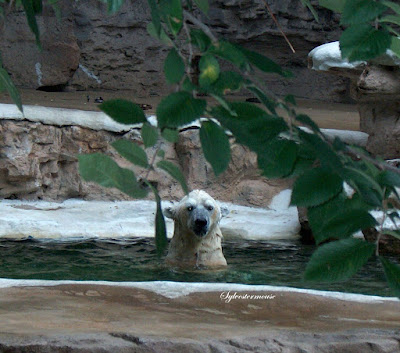 Since Polar Bears live in the Arctic, most of us will only ever see them in zoos. In their natural habitat, their white fur helps to camouflage them against the ice of their region. However, that white fur is quite a contrast to the greens and browns of other terrains.
Since Polar Bears live in the Arctic, most of us will only ever see them in zoos. In their natural habitat, their white fur helps to camouflage them against the ice of their region. However, that white fur is quite a contrast to the greens and browns of other terrains.The Polar Bear has a longer neck than other bears which allows them a longer reach when hunting their aquatic prey. They have huge paws with bumpy pads that naturally help them get a grip in the ice of their Arctic region. They have small ears & short tails which helps reduce heat loss.
Even though I enjoy seeing Polar Bears in zoos, I often feel quite sorry for them. They are most often panting due to the heat. Even in colder weather, it is rarely cold enough for a Polar Bear to be truly comfortable. In the zoo, the bears cool down by swimming in the pools in their enclosures. Several of the zoos that I have visited have viewing areas so you can watch the bears swim underwater. It is entertaining for us to watch a bear swim, but for them, it is quite refreshing and a great reprieve from the heat.
Sea Bears
Polar Bears are also referred to as Sea Bears. They are actually the only bear classified by several countries as a marine mammal. Their paws are also wide and flat which helps them to propel through water in spite of their massive size. Think of a paddle on a boat and how it can move a boat even without current.
Polar Bears are excellent swimmers and have no trouble whatsoever swimming underwater.
Facts About Polar Bears
- Black Skin Covered with 2 Layers of White Fur
- Height: Up to 10 feet tall
- Weight: Up to 1100 lbs.
- Life Span: Up to 30 years
- Nickname: Sea Bear
- Lives In: Arctic Regions: Alaska (US), Canada, Greenland, Russia & Norway
- Food: Seals, Reindeer, Fish, Seabirds, bird eggs and berries
- Cubs: 1 - 4 Cubs born every 2 - 4 years
- Currently: Vulnerable Status, but numbers are decreasing
Polar Bears You Can Take Home!
Note: The author may receive a commission from purchases made using links found in this article. “As an Amazon Associate I earn from qualifying purchases.”




What a cool photo of a swimming sea bear! I too feel sorry for them when they look hot and uncomfortable.
ReplyDeleteGreat polar bear pictures! I especially like seeing the polar bear swimming underwater. I, too, feel sorry for polar bears living in zoos in warm climates.
ReplyDeleteI love Polar bears. They are best in their natural cold environments but as you say if in captivity they do need places to keep cool. So sad they are on the vulnerable list, we need to look after our wild creatures much better. Beautiful photographs...
ReplyDeleteLove polar bears!
ReplyDeleteIt is fascinating how suited each animal is for its native environment. I've learned something new about Polar bears, thanks to you.
ReplyDelete